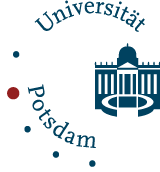The New Palace
Am Neuen Palais Campus
At the western end of Sanssouci Park, right behind the New Palace, the campus Am Neuen Palais can be found. Its buildings are amongst the most historic of Potsdam's scientific community: the majority of the campus' buildings originate from the time of Frederick the Great. After World War II scientific comeback also began here: the "Brandenburgische Landeshochschule", a state college founded in 1948, was the largest in Brandenburg. From 1951 to 1990 it was a teacher training college. Today the university's administration, the Faculty of Arts, and the institutes of sports sciences and mathematics are located at this historic site.
The building
Coming from the New Palace one walks – today as back then – through a beautiful chestnut grove towards the building where the "auditorium maximum", the main lecture hall of the university is located. A bust portraying Karl Liebknecht, who has lent his name to the teacher training college since 1971, used to stand right in front of the main portal. When the college became the University of Potsdam in 1991, the name disappeared and with it went the large lettering and the bust. What remains is the chestnut grove, which grants the fore court the charm of a park, especially when the trees are in bloom.
Under the roof
The auditorium maximum of the University of Potsdam is quite presentable; the festive hall seats about 400 people. But also the history of this room does not lack "size": after all the building in which the hall is located used to be the imperial stables. Finished in 1894 the magnificent indoor riding hall was reserved for Emperor William II and his horses. When he went into exile in the Netherlands in 1919, other 'tenants' moved in: the post, the police, the military. In the 1950s a suspended ceiling was built into the hall and instead of horses and riders professors and students moved into the attic, as it were.
Together
It's the "Communs" (from French: "common") that give the university its face – literally. The university's logo shows the side of the buildings with its two semicircular stairs that are facing the New Palace. The president's office and the central administration offices of the university are located in the southern building. However, the buildings initially were anything but "stately": after their erection from 1766 to 1769 the kitchen and the chambers for the domestic staff were located here, rooms of the royal cavalry at best. Nowadays "Commun" stands less for 'common' than for 'jointly' because many lectures and courses are being held in the building as well. And the lawn can be used by everybody, anyway.
History in every stone
The ghost of past times also wafts through the northern of the two Communs: it used to be a guesthouse for the king's visitors. But it was equipped quite spartanly: "two iron bedsteads, two ordinary mattresses, (…) one commode, (…) two stools" and nothing more for the king's guests around 1799. That definitely did not change when the building was turned into barracks – the most presentable Prussian barracks as it were – and the 1st company of the royal demonstration and infantry battalion moved in. Only after the 2nd World War, when the teacher training college moved into the premises, did a different spirit move in as well. Today it houses the Faculty of Arts.






























